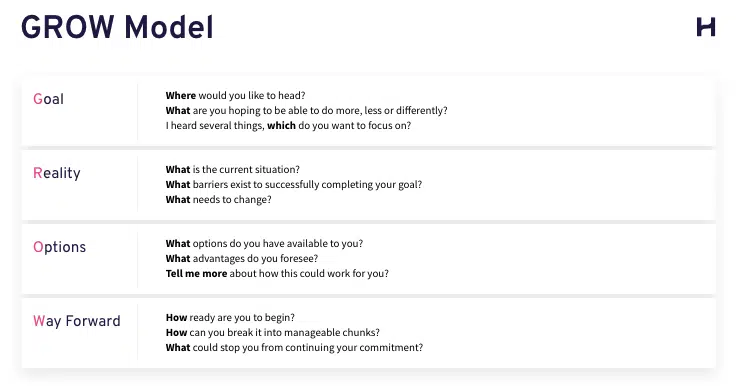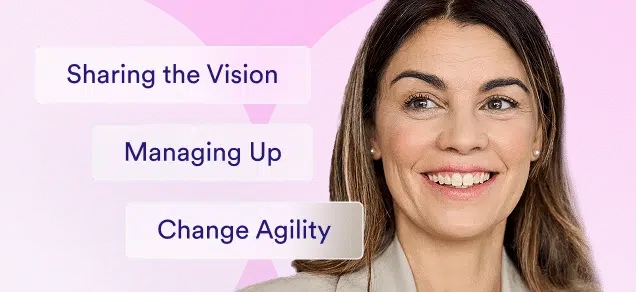Every company wants its managers to have the skills they need to lead a successful team. But, between meeting team goals, investing in employees, and pushing projects over the finish line, most managers are too busy to make time to invest in their leadership skills.
That’s why L&D teams are so crucial to business success. By identifying skill gaps and creating and facilitating manager training, L&D leads can ensure every manager prioritizes their own professional development and has the skills they need to lead a team.
One skill every modern manager needs in their skillset? Coaching.
Coaching is the process of giving employees the resources, knowledge, and opportunities they need to succeed and achieve their professional goals. It’s often used by managers when teams get “stuck.”
Like when a project’s progress stalls, a direct report feels stuck in her career, or if team morale is down after not hitting team targets. Whatever the reason, managers are responsible for assessing the situation, making changes, and getting things moving again.
If that seems ambiguous, don’t worry. There’s a development strategy that can help leaders coach their teams through gridlock. It’s called the GROW coaching model. Here’s what the GROW model is and how to train your company’s managers to use it to coach their teams:
What is the GROW coaching model?
The GROW coaching model was first coined by Sir John Whitmore and his colleagues in the book, Coaching for Performance. GROW is an easy-to-remember acronym, meaning: Goal, Reality, Options, Will.


We will cover each section of the GROW coaching model in more depth below:
1. Goal
Every GROW coaching conversation starts by clarifying an employee’s goal.
Encourage managers to ask questions like, “What do you really want?” or “What do you hope to get out of your time in this role or at this company?” to get to the bottom of how their direct report really feels or what they want out of their career. Once they’ve identified what it is their employees want, managers and employees need to work together to create a SMART goal to measure success. For example, if an employee wants to get a promotion, their goal might be, “Get promoted to Senior Product Marketer in the next 6 months.”
Once a manager has identified a goal for their coaching session, they can move on to the next step in the GROW coaching model, reality.
TIP: Remember to make a goal SMART, or specific, measurable, attainable, and timely. The more specific the goal, the more likely the GROW coaching model will lead to a successful outcome.
2. Reality
Next, managers need to direct the conversation to touch on the reality of the situation.
Encourage them to ask questions like:
- Where do things stand now?
- What’s working in the current situation?
- What are some obstacles that could get in the way of success?
- What steps have already been taken?
You can’t fix gridlock until you understand why it exists. Looking at the reality of the situation helps your managers and their direct reports understand what needs fixing and assess the broader scenario before moving forward to the next step.
3. Options
There are always options. In this stage of the GROW coaching model, you should instruct your managers to help their employees explore their options.
Imagine a manager and their report are looking at a vase of flowers on the table. If they are on opposite sides of the table, they both have a different view of and perspective on the same flowers sitting in front of both of them. The manager may see different colors or different varieties of flowers than their direct report. As a coach, your managers’ job is to help rotate that vase and help their employees see things from a different perspective and grow as a result.
Teach them to ask questions like:
- What other options do you see?
- What is your best-case, ideal approach to this situation?
- Who could help you with that idea?
- What are some possible outcomes with that idea?
4. Will or way forward
While the momentum of many conversations stops after a brainstorm, the GROW model moves participants to an outcome. This step is sometimes called “will” or, as we prefer at Hone, “way forward.” This is the final stage of the GROW coaching model and the time to identify and establish clear next steps.
At this stage, you should have manager’s ask their direct report:
- What will you do?
- What else will you do?
- When will you do this?
- What can I help with to get this done?
- When and how should we check in on progress?
If the next step still seems unclear, circle back and ask questions around Goal, Reality, and Options again.

Photo by Anete Lusina on Pexels
Teaching the GROW model
Before you unleash your managers to try their coaching powers on someone else, encourage them to practice, practice, practice. Your internal GROW model training session should include ample opportunities for situational role-playing so managers can practice using these skills before their conversations with direct reports.
In your next training program, ask people leaders to get with a partner and practice using the GROW coaching model on a specific work goal they want to accomplish in the next week or month. Then, have them write out the steps and their thoughts on each stage to cement your learnings. Lastly, have them practice having the conversation with their partner and coaching them through their answers.
Here’s an example: Let’s say you’re challenged by a relationship with your peer Sam. You two are tasked with launching a marketing campaign in time for an event next month, but, you’re behind schedule because your working relationship hasn’t clicked yet.
Let’s practice the GROW model together.
-
Grow:
Coach: What’s your goal?
Employee: I want to launch the marketing campaign on time and I also want the process to be efficient and smooth.
-
Reality:
Coach: Where do things stand now?
Employee: The project is moving forward slowly and I’m afraid we’re going to miss the deadline. I’ve been very frustrated by the process of working with Sam.
Coach: What’s not working in the current situation?
Employee: Communication has stalled — every time I connect with Sam, we both leave the conversation with different ideas of what needs to happen. Sam likes to communicate online through your chat system, but I’d prefer to talk in-person.
-
Options:
Coach: What is your best-case, ideal approach to this situation?
Employee: We sit down in person and address the challenge. Ideally, we decide on how we’ll communicate throughout the project.
Coach: What other options do you see?
Employee: Well…
- We could push through this project and address the issue in the post-mortem.
- I could try to change partners for the project.
- I talk to my manager about the issue.
- I adapt my communication style to meet Sam’s.
- I ask Sam to adapt his communication style to meet mine.
-
Will:
Coach: What will you do?
Employee: Because we’re so far behind on this project already, I think I need to adapt my communication style to meet Sam’s. Once the project is over, we’ll need to sit down and figure out a better process moving forward.
Manager: When will you do this?
Employee: We are supposed to have an in-person meeting to sync on progress tomorrow, but I’ll message Sam and ask if we can catch up over chat instead. Hopefully, he is more responsive and accountable over chat.
Manager: When and how should we check in on progress?
Employee: Let’s talk again after I talk with Sam tomorrow so I can let you know how it went and we can decide the best way to proceed.
While the GROW coaching model is an effective way to push employees to pursue their goals, it isn’t the only coaching framework out there.
If you’re looking for a scalable way to teach your company’s managers the GROW coaching model and other coaching frameworks, click here to talk with a member of the Hone team about getting a free trial for yourself and your team.
Once you’ve activated your trial, you can enroll in one of Hone’s most popular courses, The Coach Approach, and learn how to deepen your listening skills, acknowledge the experiences of others, ask powerful questions to move the conversation forward in powerful ways, and more.











